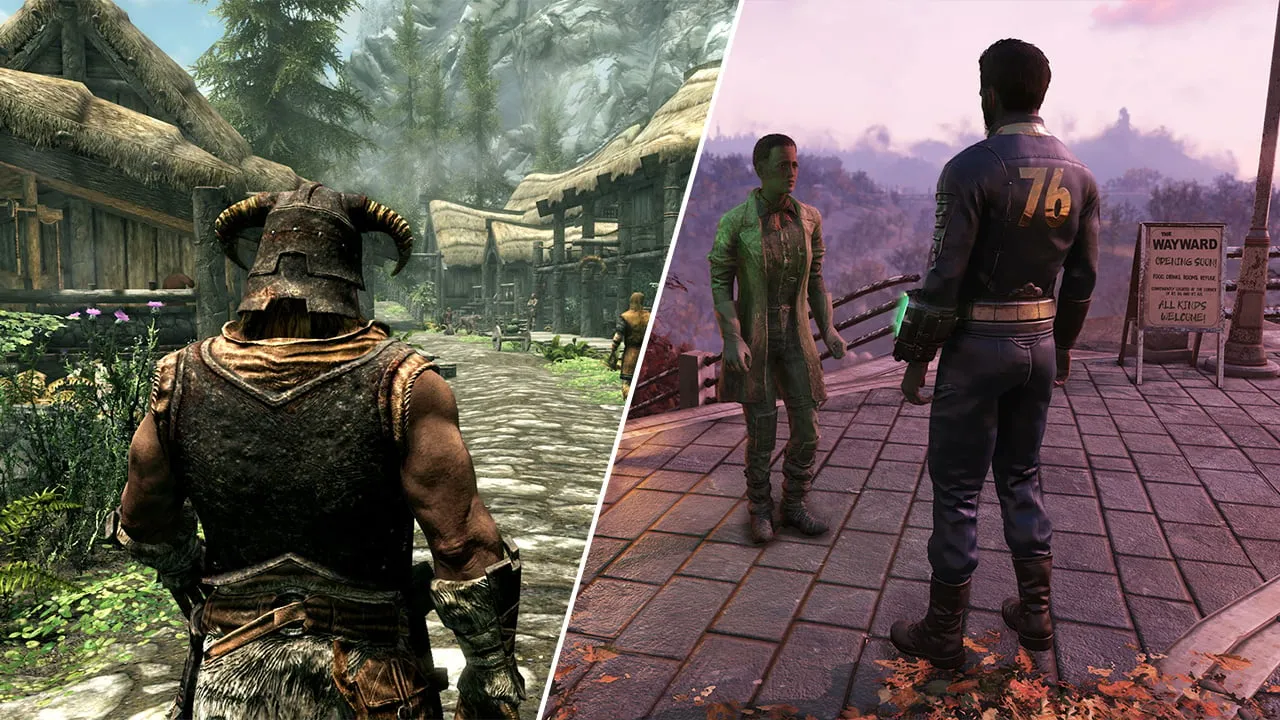Bethesda RPGs: Secrets Behind Their Believable Worlds

Bethesda RPGs have long captivated players with their immersive worlds, filled with intricate details that often go unnoticed. These elements contribute to a vibrant, reactive environment that makes adventuring feel authentic. Jeff Gardiner, a former producer at Bethesda, reflects on his 15-year journey with the company, highlighting the creative freedom that allowed teams to infuse their games with unique quirks and complexities. From the curious butterflies of Skyrim to the shadow-casting ants, Gardiner shares insights into the delightful—and sometimes challenging—process of crafting a living world, setting the stage for an exploration of the art and challenges behind Bethesda’s beloved titles.
| Aspect | Details |
|---|---|
| Developer | Bethesda and Something Wicked Games |
| Key Person | Jeff Gardiner |
| Game Series | Fallout and The Elder Scrolls |
| Unique Features | Subtle details that create a believable world |
| Creative Freedom | Teams had freedom to explore ideas post-task completion |
| Challenges Faced | Resource-intensive features causing lag (e.g., butterflies and ants) |
| Butterflies in Skyrim | Followed players carrying flowers, causing performance issues |
| Ants in the Game | Shadow casting led to high resource demands |
| Overall Experience | Cherished memories despite challenges; creativity fostered by trust from Zenimax |
The Magic of Subtle Details in Bethesda RPGs
Bethesda RPGs, like Skyrim and Fallout, are known for their engaging and immersive worlds. One of the main reasons players feel so connected to these games is the tiny details that often go unnoticed. For example, butterflies and ants in Skyrim aren’t just there for decoration; they add life to the environment. These details help players feel like they are truly part of a bustling world, where even the smallest creatures contribute to the overall experience.
Former Bethesda producer Jeff Gardiner highlights how these small elements create a living, breathing world. Players don’t just kill an enemy or steal a flower; they experience reactions and interactions that make the game feel real. The sense of a world around them, full of surprises and unexpected encounters, keeps players coming back for more. It’s not just about the main quests; it’s about exploring the little things that make each adventure unique.
Creative Freedom and Its Challenges at Bethesda
Working at Bethesda, teams enjoyed a lot of creative freedom when developing games. Gardiner remembers how, once the main tasks were completed, the team could focus on adding special touches that made the games stand out. This freedom allowed artists and programmers to think outside the box, giving us memorable features like the butterfly-following mechanic in Skyrim. However, this creativity sometimes led to unexpected problems that could slow down game performance.
For instance, Gardiner recalls the challenges posed by ants that cast shadows. While including tiny, cute creatures was a fun idea, it became a headache when developers realized this feature was demanding too much from the game’s systems. Even the smallest details can lead to big challenges, but Gardiner believes that facing these obstacles is part of what makes game development exciting. The balance between creativity and technical limitations is what keeps the process interesting.
The Importance of Trust in Creative Development
A key factor in Bethesda’s success was the trust that their parent company, Zenimax, placed in them. Gardiner explains that this trust allowed the team to set their own goals and milestones, fostering a creative environment. When developers feel safe to experiment and take risks, they can create truly remarkable games. This freedom to innovate is essential for any creative project, especially in the gaming industry, where new ideas can lead to exciting advancements.
With this level of autonomy, Bethesda was able to create beloved franchises that resonate with players. Gardiner fondly remembers how this environment encouraged fun and creativity, leading to the intricate and lively worlds that players love. The success of their games provided them with the freedom to explore new ideas, ensuring that each title was filled with unique details that made games like Fallout and The Elder Scrolls memorable experiences.
The Subtle Magic of Bethesda’s World-Building
Bethesda RPGs are celebrated for their immersive worlds, and this is largely due to the subtle details woven throughout the gameplay. From the ambient sounds of nature to the intricate dialogue options, players often find that these elements create a sense of realism and depth. It’s not just about the grand quests; it’s the small interactions, like a passerby commenting on the weather or a character’s unique habits, that make the world feel alive and responsive to players’ actions.
These layers of detail contribute to a player’s emotional investment in the game. Each small discovery, whether it’s an unusual item or an unexpected encounter, enhances the feeling of exploration and wonder. This approach allows players to feel like they are part of a living, breathing world where every decision matters and every action can lead to surprising outcomes, transforming the gaming experience into something truly memorable.
Creative Freedom and Its Challenges
Jeff Gardiner’s insights into the creative processes at Bethesda reveal a fascinating balance between freedom and structure. The teams were encouraged to explore their imaginative concepts, leading to unique features that defined titles like Fallout and The Elder Scrolls. However, this freedom didn’t come without its complications, especially when certain ideas, like the butterfly and ant systems, began to strain the game’s performance. These challenges highlight the intricate relationship between creativity and technical feasibility in game development.
Gardiner’s anecdotes illustrate how experimental features can lead to both delightful gameplay moments and technical headaches. The introduction of seemingly minor elements, such as butterflies reacting to player inventory, can unexpectedly impact overall game performance. This duality of creativity underscores the importance of balancing innovation with practical constraints, ensuring that the end product remains engaging without compromising functionality.
The Importance of Player Agency in RPGs
In Bethesda RPGs, player agency plays a crucial role in shaping the gaming experience. The ability to make choices that influence the world around you fosters a deeper connection to the storyline and characters. Gardiner emphasizes that these choices are not merely cosmetic; they impact how NPCs react to players, creating a sense of consequence that keeps players engaged. The feeling of inhabiting a world where one’s actions matter is a cornerstone of the immersive experience.
This emphasis on player-driven narratives allows for diverse gameplay styles, catering to a wide range of preferences. Whether players choose to be heroic, villainous, or somewhere in between, the game adapts to their decisions. This flexibility not only enhances replayability but also makes each player’s journey unique, reinforcing the idea that every choice contributes to the vibrant tapestry of the game world.
Nurturing Creativity Through Trust
Gardiner’s reflections on Bethesda highlight how a culture of trust and autonomy can foster creativity within a team. By allowing developers to set their own milestones and explore their ideas, Bethesda cultivated an environment where innovation thrived. This approach not only empowered teams to take risks but also encouraged the development of features that might seem unconventional, like the playful interactions with insects, ultimately enriching the gaming experience.
Such creative freedom is vital in a medium where artistic expression and technical skill intersect. When developers feel supported in their endeavors, they are more likely to produce groundbreaking content that resonates with players. Gardiner’s experiences serve as a testament to the idea that a nurturing environment can yield extraordinary results, transforming ambitious concepts into beloved game mechanics that define the Bethesda legacy.
Frequently Asked Questions
What makes Bethesda RPGs feel like a real world?
Bethesda RPGs feel real because they have **small details** that react to what you do, like people noticing your actions and a world that seems alive around you.
Who is Jeff Gardiner and what did he do at Bethesda?
Jeff Gardiner was a **producer** at Bethesda for 15 years. He helped create games like Fallout and The Elder Scrolls, focusing on making them detailed and immersive.
Why did butterflies in Skyrim slow down the game?
In Skyrim, butterflies would follow you if you had flowers, but this was **resource-intensive**. It made the game slower because it required a lot of processing to check for flowers.
What happened with the ants in the game?
The artist added ants that cast **tiny shadows**, which slowed down the game. This was a problem because shadow casting took up a lot of resources, even if the ants were small.
How did Bethesda teams get to be creative?
Bethesda teams had a lot of **freedom** to explore their ideas. Once they finished their main tasks, they could work on fun details, which made the games richer and more exciting.
What challenges did Bethesda face with their creative freedom?
While creative freedom was great, it sometimes led to **challenges** like game slowdowns or bugs. These issues had to be fixed before the games could be released.
What did Jeff Gardiner learn from his time at Bethesda?
Gardiner learned that having **trust** from their parent company allowed the team to be creative. This trust helped them set their own goals and make amazing games.
Summary
The content discusses the creative freedom experienced by developers at Bethesda, as shared by former producer Jeff Gardiner. He highlights how this autonomy contributed to the rich details in games like Fallout and The Elder Scrolls, making the worlds feel alive and reactive. However, this freedom also led to challenges, such as performance issues caused by intricate features like butterflies and ants interacting with the game environment. Despite these challenges, Gardiner reflects positively on his experiences, emphasizing that the ability to set their own goals fostered creativity, ultimately enhancing the gaming experience for players.






